
Principles and Applications of Asymmetric Synthesis
.pdf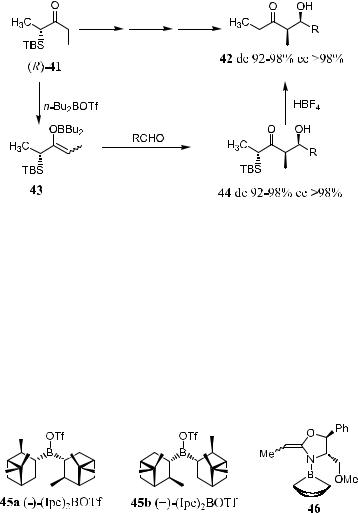
150 ALDOL AND RELATED REACTIONS
3.2.5 a -Silyl Ketones
a-Silyl ketones of type 41 can be employed in aldol reactions, and syncon®gurated b-hydroxy ketone 42 can be obtained in high de and ee. Direct aldol reaction for the synthesis of b-hydroxy ketones is less widely used because of its low ee value. Thus, (R)-41 can be converted to the corresponding boron enolate via the reaction with n-Bu2BOTf in CH2Cl2. The resulting compound is then reacted with the aldehyde at ÿ78 C, giving the aldol product 44 with 92± 98% de and more than 98% ee. After desilylation with 60% aqueous tetra- ¯uoroboric acid, the syn-aldol 42 can be obtained with high de and ee (Scheme 3±16).34
Scheme 3±16
3.3REAGENT-CONTROLLED ALDOL REACTIONS
3.3.1Aldol Condensations Induced by Chiral Boron Compounds
Boron tri¯ates 45a and 45b are very useful chiral auxiliaries. Boron azaenolate derived from achiral35 and chiral36 oxazolines gives good stereoselectivity in the synthesis of acyclic aldol products, particularly for the rarely reached threoisomers. By changing the chiral auxiliary, the stereochemistry of the reaction can be altered.37
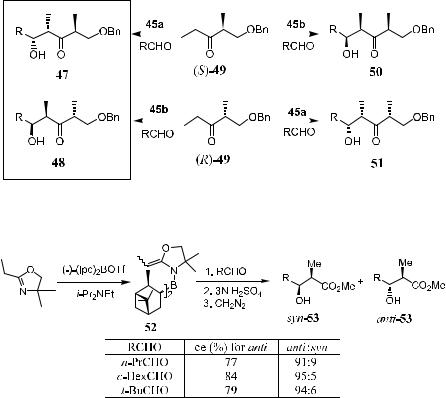
|
3.3 REAGENT-CONTROLLED ALDOL REACTIONS |
151 |
|||||||||||
|
|
|
|
|
|
|
|
|
|
|
|
|
|
|
|
|
|
|
|
|
|
|
|
|
|
|
|
|
|
|
|
|
|
|
|
|
|
|
|
|
|
|
|
|
|
|
|
|
|
|
|
|
|
|
|
|
|
|
|
|
|
|
|
|
|
|
|
|
|
|
|
|
|
|
|
|
|
|
|
|
|
|
|
|
|
|
|
|
|
|
|
|
|
|
|
|
|
|
|
|
|
|
|
|
|
|
|
|
|
|
|
|
|
|
|
|
|
|
|
|
|
|
|
|
|
Scheme 3±17
Scheme 3±18
Starting from ketone(R)-/(S)-49, the asymmetric aldol reaction with aldehyde in the presence of 45a or 45b a¨ords all four isomers of b-hydroxyl ketone 47, 48, 50, and 51 with high yields and stereoselectivities (Scheme 3±17).
Treating boron reagent 45a with an oxazoline compound gives the azaenolate 52. Subsequent aldol reaction of 52 with aldehyde yields mainly threoproduct (anti-53) with good selectivities (Scheme 3±18).38
When a chiral auxiliary is present in the oxazoline ring and the boron part is replaced with an achiral bicyclic system (46 bearing 9-BBN), erythro-b-hydroxy esters (syn-53) can be obtained as the major product upon reaction of the enolate with several aldehydes.37
3.3.2Aldol Reactions Controlled by Corey's Reagents
Corey et al.39 introduced a chiral controller system, chiral auxiliary 55, which has shown excellent practical potential because of its availability, recoverability, and high enantioselectivity. Furthermore, using conformation analysis,
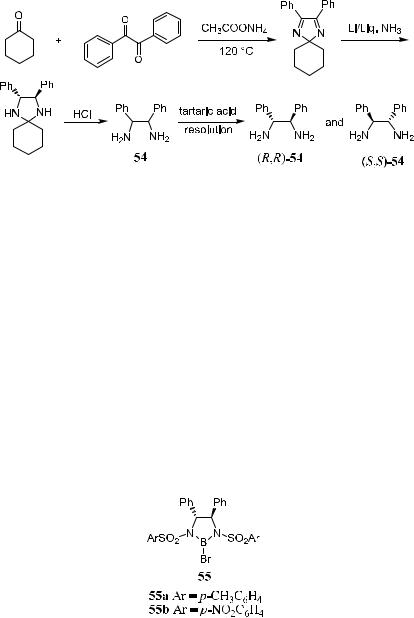
152 ALDOL AND RELATED REACTIONS
Scheme 3±19. Synthesis and resolution of chiral compound 54.
the absolute con®guration of the product can be predicted when 55 is involved in the reaction (see Scheme 3±20 and Table 3±5, later, for some examples). Starting from benzil, compound 1,2-diamino-1,2-diphenylethane (stilbenediamine) is synthesized. Using tartaric acid as the resolving agent, stilbenediamine in both …R,R†- and …S,S†-forms can be obtained.40 Scheme 3±19 depicts the synthesis of both isomers of 54. Compound 54 is a key compound for synthesizing 55 and related compounds.
Conversion of diamine 54 to bis-sulfonaminde, followed by treatment with BBr3, yields the corresponding catalyst 55. Application of this controller in enantioselective aldol reactions has led to striking success. The reaction can be used not only in aldol reactions but also in allylation reactions. Treating a solution of 55a with allyl tributyltin results in chiral allyl borane, and reaction of this allyl borane with a variety of aldehydes gives the corresponding homoallyl alcohols with high enantiomeric excess (>90%).41 The allylation reaction is discussed in detail in a later section.
As illustrated in Scheme 3±20 and Table 3±5, using 55a or 55b as the chiral auxiliary, syn-aldol adduct 56 can be obtained with high stereoselectivity via aldol reaction of diethyl ketone with various aldehydes.39
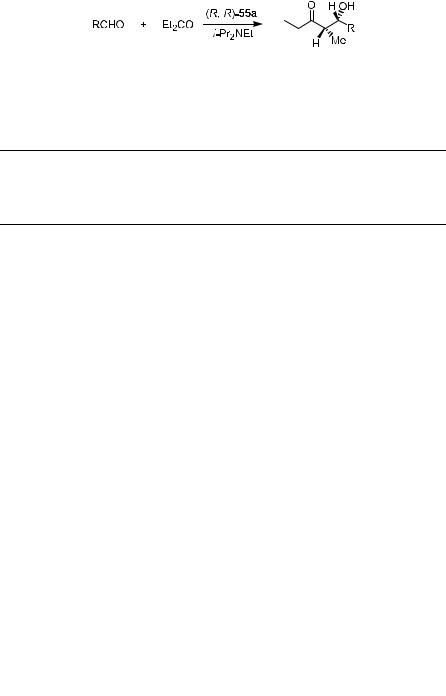
3.3 REAGENT-CONTROLLED ALDOL REACTIONS |
153 |
Scheme 3±20
TABLE 3±5. Reaction of Aldehydes with the Enolate from Diethyl Ketone and Bromoborane (R,R)-55b
RCHO |
Yield (%) |
syn:anti |
ee (%) |
|
|
|
|
PhCHO |
95 |
94.3:5.7 |
97 |
Me2CHCHO |
85 |
98:2 |
95 |
EtCHO |
91 |
>98:2 |
>98 |
ee ˆ Enantiomeric excess.
Reprinted with permission by Am. Chem. Soc., Ref. 39.
With 55 as the chiral auxiliary, good enantioselectivity can be obtained in reactions between aldehydes and esters. In the case of phenyl thioacetate, as depicted in Scheme 3±21, an aldol reaction induced by 55a or 55b can also give acceptable stereoselectivity.
It is proposed that stereochemistry of the controlled aldol addition originates when the phenyl groups of the stien ligand force the vicinal N-sulfonyl substituents to occupy the face of the ®ve-membered ring opposite the face where they are linked. The optimized stereoelectronic and steric arrangements of the favored transition state for the formation of the major product are depicted in Figure 3±4.
Scheme 3±21
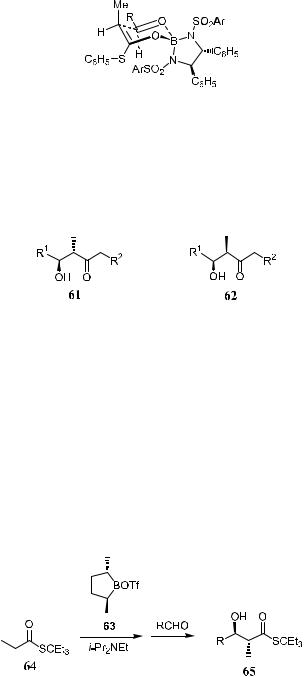
154 ALDOL AND RELATED REACTIONS
Figure 3±4. Transition state.
3.3.3Aldol Condensations Controlled by Miscellaneous Reagents
Both antiand syn-3-hydroxy-2-methylcarbonyl units (e.g., 61 and 62) are frequently embedded in natural products of propionate origin, such as macrolide antibiotics.
Double asymmetric aldol reaction has been widely used for the e½cient construction of the syn-unit.10b,42 With above-described organoboron compounds (Section 3.3.1), anti-selectivity can be obtained.
Because anti/syn ratios in the product can be correlated to the E…O†=Z…O† ratio of the involved boron enolate mixture,10b initial experiments were aimed at the preparation of highly E…O†-enriched boron enolate. The E…O†=Z…O† ratio increases with the bulk of the alkanethiol moiety, whereas the formation of Z…O† enolates prevails with (S)-aryl thioates. (E=Z ˆ 7:93 for benzenethiol and 5:95 for 2-naphthalenethiol esters). E…O† reagent can be formed almost exclusively by reaction of (S)-3,3-diethyl-3-pentyl propanethioate 64 with the chiral boron tri¯ate. High reactivity toward aldehydes can be retained in spite of the apparent steric demand (Scheme 3±22).43
Scheme 3±22
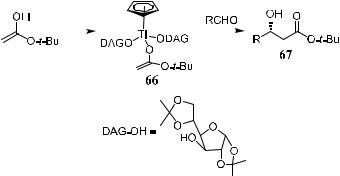
3.4 CHIRAL CATALYST-CONTROLLED ASYMMETRIC ALDOL REACTION |
155 |
||||||
|
|
|
|
|
|
|
|
|
|
|
|
|
|
|
|
Scheme 3±23
Covalently bonded chiral auxiliaries readily induce high stereoselectivity for propionate enolates, while the case of acetate enolates has proved to be di½cult. Alkylation of carbonyl compound with a novel cyclopentadienyl titanium carbohydrate complex has been found to give high stereoselectivity,44 and a variety of b-hydroxyl carboxylic acids are accessible with 90±95% optical yields. This compound was also tested in enantioselective aldol reactions. Transmetalation of the relatively stable lithium enolate of t-butyl acetate with chloro(cyclopentadienyl)-bis(1,2:5,6-di-O-isopropylidene-a-d-glucofuranose-3- O-yl)titanate provided the titanium enolate 66. Reaction of 66 with aldehydes gave b-hydroxy esters in high ee (Scheme 3±23).
As the t-butyl group can readily be removed upon acidic or basic hydrolysis, this method can also be used for b-hydroxyl acid synthesis. In analogy with allylation reactions, the enolate added preferentially to the Re-face of the aldehydes in aldol reactions. Titanium enolate 66 tolerates elevated temperatures, while the enantioselectivity of the reaction is almost temperature independent. The reaction can be carried out even at room temperature without signi®cant loss of stereoselectivity. We can thus conclude that this reaction has the following notable advantages: High enantiomeric excess can be obtained (ee > 90%); the reaction can be carried out at relatively high temperature; the chiral auxiliary is readily available; and the chiral auxiliary can easily be recovered.44
3.4 CHIRAL CATALYST-CONTROLLED ASYMMETRIC ALDOL REACTION
3.4.1Mukaiyama's System
Thus far, most of the stereoselective approaches to aldol reactions mentioned have depended on substrate-based asymmetric induction by employing chiral
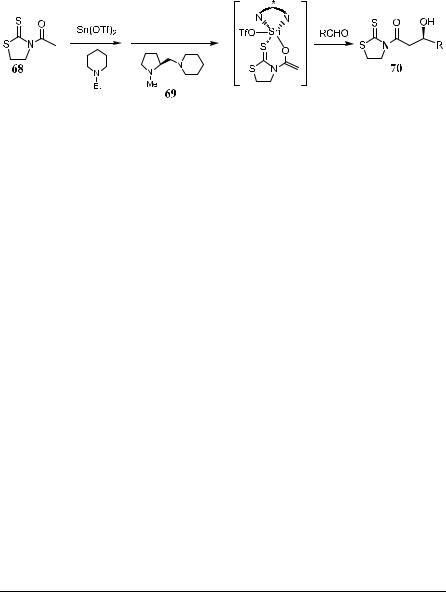
156 ALDOL AND RELATED REACTIONS
Scheme 3±24
enolates or chiral aldehydes. In addition to their discovery of the usefulness of enol equivalents in aldol reactions, Mukaiyama et al.45 also demonstrated that tributyltin ¯uoride, stannous tri¯ate, or trityl tri¯ates are even more e¨ective reagents for aldol reactions. Based on the concept of ``enol species'', they developed various highly selective and practical asymmetric reactions, particularly stannous tri¯ate-mediated aldol reactions. Divalent tin has vacant d orbitals that enable it to form complexes with amines. The tin(II) metal is bonded with two nitrogen atoms, leaving one vacant orbital coordinatable to an aldehyde without losing the favorable chiral environment. Almost complete stereochemical control is therefore achieved starting from achiral aldehyde and silyl enol ethers with a catalytic amount of diamine.46 Thus, compound 68 is ®rst treated with Sn(OTf )2 and a chiral amine 69, followed by an aldehyde, yielding b-cyclohexyl (S)-imide 70 in about 90% ee (Scheme 3±24).47
In the presence of a chiral promoter, the asymmetric aldol reaction of prochiral silyl enol ethers 71 with prochiral aldehydes will also be possible (Table 3±6). In this section, a chiral promoter, a combination of chiral diaminecoordinated tin(II) tri¯ate and tributyl ¯uoride, is introduced. In fact, this is the ®rst successful example of the asymmetric reactions between prochiral silyl enol ethers and prochiral aldehyde using a chiral ligand as promoter.
As depicted in Scheme 3±25, the aldol reaction carried out at ÿ78 C can give the corresponding aldol adduct 72 in 78% yield with 82% ee. The combination of chiral diamine-coordinated tin(II) tri¯ate and tributyltin ¯uoride is so essential that the enantioselectivity cannot be obtained without tributyltin ¯u-
TABLE 3±6. The Reaction of Silyl Enol Ether of S-Ethyl Ethanethiate with Benzaldehyde
Promoter |
|
Yield (%) |
ee (%) |
|
|
|
|
Sn(OTf )2 ‡ chiral diamine A |
74 |
0 |
|
Sn(OTf )2 |
‡ chiral diamine A‡ n-Bu3SnF |
78 |
82 |
Sn(OTf )2 |
‡ chiral diamine B‡ n-Bu3SnF |
52 |
92 |
Sn(OTf )2 |
‡ chiral diamine C‡ n-Bu3SnF |
74 |
78 |
ee ˆ Enantiomeric excess.
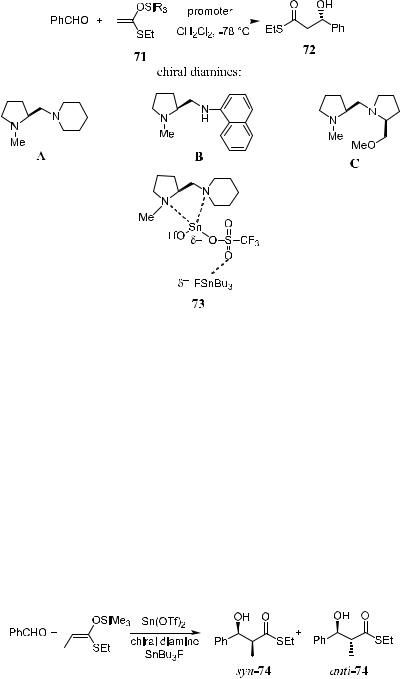
3.4 CHIRAL CATALYST-CONTROLLED ASYMMETRIC ALDOL REACTION |
157 |
||
|
|
|
|
Scheme 3±25
oride in the reaction system. When Bu3SnF was present, diamine A induced good yield for the product. The reaction induced by diamine B gives a higher ee but a moderate yield (Table 3±6).
It has been proposed that the reaction is promoted by the formation of the active species 73, in which, the cationic center of the tin(II) tri¯ate activates an aldehyde, and, at the same time, the electronegative ¯uoride is able to interact with a silicon atom of the silyl enol ether to make the enol ether more reactive. This dual process results in the formation of the entropically favored intermediate (Scheme 3±25).46
Perfect stereochemical control in the synthesis of syn-a-methyl-b-hydroxy thioesters has been achieved by asymmetric aldol reaction between the silyl enol ether of S-ethyl propanethioate (1-trimethylsiloxy-1-ethylthiopropene) and aldehydes using a stoichiometric amount of chiral diamine-coordinated tin(II)
Scheme 3±26

158 |
ALDOL AND RELATED REACTIONS |
|
|
|
|
TABLE 3±7. E¨ect of Chiral Diamine |
|
|
|
||
Chiral Diamine |
Time (h) |
Yield (%) |
syn:anti |
ee (%) |
|
|
|
20 |
80 |
93:7 |
80 |
|
|
3 |
86 |
100:0 |
>98 |
|
|
20 |
77 |
88:12 |
44 |
ee ˆ Enantiomeric excess.
tri¯ate and tributyltin ¯uoride or n-Bu2Sn(OAc)2 as chiral promoters (Scheme 3±26). The e¨ect of chiral diamine on the stereo-outcome of the product is shown in Table 3±7.45
This method has been applied in the enantioselective synthesis of d-erythro- sphingosine and phytosphingosine. Sphingosine became an important substance for studying signal transduction since the discovery of protein kinase C inhibition by this compound.48 Many e¨orts have been made to synthesize sphingosine and its derivatives.49 Kobayashi et al. reported another route to this type of compound in which a Lewis acid±catalyzed asymmetric aldol reaction was a key step.
In the synthesis of d-erythro-sphingosine (78 without BOC protection), the key step is the asymmetric aldol reaction of trimethylsilylpropynal 75 with ketene silyl acetal 76 derived from a-benzyloxy acetate. The reaction was carried out with 20 mol% of tin(II) tri¯ate chiral diamine and tin(II) oxide. Slow addition of substrates to the catalyst in propionitrile furnishes the desired aldol adduct 77 with high diastereoand enantioselectivity (syn/anti ˆ 97:3, 91% ee for syn). In the synthesis of protected phytosphingosine (80, OH and NH2 protected as OAc and NHAc, respectively), the asymmetric aldol reaction is again employed as the key step. As depicted in Scheme 3±27, the reaction between acrolein and ketene silyl aectal 76 proceeds smoothly, a¨ording the desired product 80 with 96% diastereoselectivity (syn/anti ˆ 98:2) and 96% ee for syn (Scheme 3±27).50
For a comprehensive review of Sn(II) catalyst systems, see Nelson's review article, Catalyzed Enantioselective Aldol Additions of Latent Enolate Equivalents.51
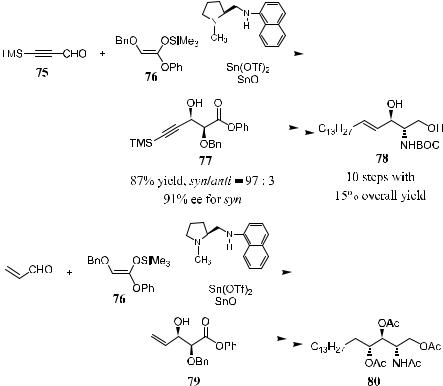
3.4 CHIRAL CATALYST-CONTROLLED ASYMMETRIC ALDOL REACTION |
159 |
|||||||||||||||||
|
|
|
|
|
|
|
|
|
|
|
|
|
|
|
|
|
|
|
|
|
|
|
|
|
|
|
|
|
|
|
|
|
|
|
|
|
|
|
|
|
|
|
|
|
|
|
|
|
|
|
|
|
|
|
|
|
|
|
|
|
|
|
|
|
|
|
|
|
|
|
|
|
|
|
|
|
|
|
|
|
|
|
|
|
|
|
|
|
|
|
|
|
|
|
|
|
|
|
|
|
|
|
|
|
|
|
|
|
|
|
|
|
|
|
|
|
|
|
|
|
|
|
|
|
|
|
|
|
|
|
|
|
|
|
|
|
|
|
|
|
|
|
|
|
|
|
|
|
|
|
|
|
|
|
|
|
|
|
|
|
|
|
|
|
|
|
|
|
|
|
|
|
|
|
|
|
|
|
|
|
|
|
|
|
|
|
|
|
|
|
|
|
|
|
|
|
|
|
|
|
|
|
|
|
|
|
|
|
|
|
|
|
|
|
|
|
|
|
|
|
|
|
|
|
|
|
|
Scheme 3±27
3.4.2 Asymmetric Aldol Reactions with a Chiral Ferrocenylphosphine±Gold(I) Complex
Ito et al.52 found that gold(I) complex containing an optically active ferrocenylphosphine ligand bearing a 2-dialkylaminoethylamino side chain was an effective catalyst for an asymmetric aldol-type reaction of a-isocyanocarboxylate (CNCHRCO2CH3), a-isocyanocarboxyamides (CNCH2CONR2), or a-iso- cyanophosphonates [CNCH2PO(OR)2] with aldehydes. This reaction can be used for b-hydroxy-a-amino acid synthesis (Scheme 3±28).
The trans-selectivity is due to steric repulsion between the alkyl substituent of the aldehydes and the large carboxylate or dialkoxy phosphinyl moiety (Scheme 3±29).53
As shown in Scheme 3±30, a,b-unsaturated aldehyde is treated with a- isocyanocarboxylate in the presence of gold complex (S)-(R)-82 to a¨ord, after several steps, d-erythro-sphingosine derivative.53b
The asymmetric aldol reaction of a-ketoesters (RCOCOOMe: RbMe, i-Bu, Ph) with methyl isocyanoacetate or N,N-dimethyl-isocyanoacetamide in the
